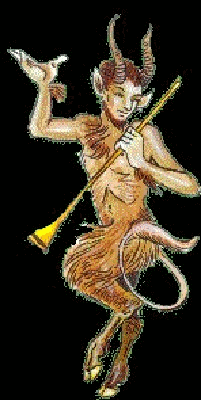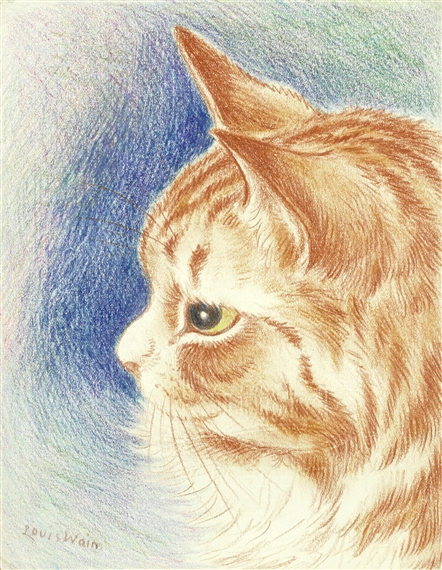I just have to unload something here. I just watched a dreadful BBC music special about the Romantics, with some godawful English lady with two curtains of hair and big teeth, narrating with a constant, fatuous smile on her face. She began to talk about De-BEWW-sea, and when introducing his masterpiece Prelude a l'apres-midi d'un faune, she informed us in her sickly cheery voice that "this marvellous orchestral feast portrays the wonder and awe of a young deer as he slowly walks through a forest glen."
A young deer. A fawn! The BBC cultural elite thinks a "faun" is Bambi, not some langorous half-drunk satyr wallowing with loose goddesses in an afternoon of guiltless debauchery.
Even Wikipedia gets it right: "The goat man, more commonly affiliated with the Satyrs of Greek mythology or Fauns of Roman (emphasis mine), is a bipedal creature with the legs and tail of a goat and the head, arms and torso of a man and is often depicted with goat's horns and pointed ears. These creatures in turn borrowed their appearance from the god Pan of the Greek pantheon. They were a symbol of fertility, and their chieftain was Silenus, a minor deity of Greek mythology."
Tom Robbins wrote an entire, gorgeous novel about Pan (Jitterbug Perfume, one of my all-time favorites), exploring the human sense of smell, its neural roots and erotic significance. Pan's no Bambi in this novel - he cavorts with the tattiest of has-been goddesses, and even in his invisible state gives off a sort of primal reek that sends his unwitting human victims into sexual frenzies. So powerful is his ponk that a magical perfume must be concocted to disguise it. The perfume is made from beet pollen, and here Robbins goes into a vegetable rhapsody unequalled in fiction:
“The beet is the most intense of vegetables. The radish, admittedly, is more feverish, but the fire of the radish is a cold fire, the fire of discontent, not of passion. Tomatoes are lusty enough, yet there runs through tomatoes an undercurrent of frivolity. Beets are deadly serious.
Slavic peoples get their physical characteristics from potatoes, their smoldering inquietude from radishes, their seriousness from beets.
The beet is the melancholy vegetable, the one most willing to suffer. You can't squeeze blood out of a turnip...
The beet is the murderer returned to the scene of the crime. The beet is what happens when the cherry finishes with the carrot. The beet is the ancient ancestor of the autumn moon, bearded, buried, all but fossilized; the dark green sails of the grounded moon-boat stitched with veins of primordial plasma; the kite string that once connected the moon to the Earth, now a muddy whisker drilling desperately for rubies.
The beet was Rasputin's favorite vegetable. You could see it in his eyes.”
(Back to me - I can't write that well!) The power of the beet and its reeking pollen (an odor which Robbins describes as "embarrassing") is the only thing that bests the animal stink of the goat. THAT goat, you know? That half-goat, unspeakably lashed to the torso of a man. No, this is not Bambi, folks, this is PAN, one of the most basic, fundamental, primal figures in all of ancient human lore, the pagan god of pagan gods, and not only that, the image most often associated with Satan. And the BBC thinks he's a little forest darling with speckles on his rear!
The huge stir this piece caused when it debuted in Paris had little to do with the sensuality of the music, and everything to do with WHAT it portrayed: a lustful pagan goat-man in full rut. But oh, no, the music historians at the BBC, ALL of them, for surely the text must have been vetted by many, think that Prelude a l'apres-midi d'un Faune is about a baby deer, a FAWN! I don't know why I expected better from a British "music expert". But shit, I knew what a "faun" was when I was eight and my parents dragged me off to classical concerts.
I knew, not because I was some musical prodigy when I was a kiddie (far from it, I was the only dud in the lot), but because I was old enough and curious enough to read the backs of album covers (a lost source of musical education in this digital age). But the best classical music programming the BBC has to offer has no idea what Debussy's masterpiece is even about. Nobody caught it, nobody corrected it, nobody edited it out, and I am beginning to wonder with a sense of despair if I am the only person who even noticed it. It's the cheapening of culture, the shallowing-down of the brimming pools in Debussy's wild pagan landscape.
An outrageous, truly filthy old satyr lolling around in blatant sexual debauchery has somehow been collapsed down into a frolicking Disney character. "Some fun, huh, Bambi?" Dear God.
And the beet goes on! Another of Robbins' inspired passages, this time about the pollen of the beet which makes up the "bottom note" of Pan's perfume:
"If the waft that streams from a freshly opened hive is intimate to the point of embarrassment (ask any sensitive beekeeper), so it is with beet pollen. There is something personal about it, and something primeval. If there is a comparable odor, it is, indeed, the moldy inner sanctum of some fermenting, bursting hive; but beet pollen is honey squared, royal jelly cubed, nectar raised to the nth power; the intensified secretions of the Earth's apiarian gland, reeking of ancient bridal chambers and intimacies half as old as time."
OK. . . I will now stop writing. For the rest of my life.
(Post-post. I HAD to smell it, I had to try to find a sample of beet pollen to see if it really reeked in that intimate, embarrassing way. And I couldn't. BUT - I had a certain house plant, until it died, with thick, dark green, spiky leaves which had a purplish down on their surface. It grew away untended, then suddenly the thing bloomed, and I could tell it had bloomed when I walked into the room: the tiny, dandelion-shaped, bright orange flowers stank of locker room, of sweat, and of all the intimate things Robbins talks about. It's possible the purple passion plant is somehow related to the beet, and its fat, aggressive leaves look similar. This is probably as close as I will get to that smell. And I do wonder, in considerable despair, if anyone now on earth can equal or surpass the lush cascading poetry of Robbins' prose.)
POST-POST-"whatever". As I try to dig up more information on beet pollen, I am finding absolutely NOTHING specific to that plant. It's as if it doesn't flower, which confuses me. All I can come up with is BEE pollen, which is obviously not what I want. For some reason, lupines came up too - the elegant, long-stemmed, bell-flowered plant I plucked on a walk around the lagoon in the summer. It's also known as foxglove, from which the heart drug digitalis is extracted. It's one of the oldest and most effective of folk remedies. But why is lupinus perennis the only image I can come up with? Is Robbins having us on by inventing a substance just to tease us?
Persistence pays off. Or, sort of. I finally found SOMETHING about beet flowers, but it pertained to sugar beets, those hard, lumpy, turnip-like things which were processed in a plant in my home town, emitting a scorchy smell of burnt sugar on hot summer days. This ISN'T the beet Robbins write about, which, incredibly, does not flower (how can you have a plant that doesn't flower?). Small, shrivelled, yellowish petals cling to a gnarly-looking stalk, and I have no idea what they smell like. But the name! The name makes this entire meandering enterprise worthwhile (and didn't we start with "faun vs. fawn"?):
The huge stir this piece caused when it debuted in Paris had little to do with the sensuality of the music, and everything to do with WHAT it portrayed: a lustful pagan goat-man in full rut. But oh, no, the music historians at the BBC, ALL of them, for surely the text must have been vetted by many, think that Prelude a l'apres-midi d'un Faune is about a baby deer, a FAWN! I don't know why I expected better from a British "music expert". But shit, I knew what a "faun" was when I was eight and my parents dragged me off to classical concerts.
I knew, not because I was some musical prodigy when I was a kiddie (far from it, I was the only dud in the lot), but because I was old enough and curious enough to read the backs of album covers (a lost source of musical education in this digital age). But the best classical music programming the BBC has to offer has no idea what Debussy's masterpiece is even about. Nobody caught it, nobody corrected it, nobody edited it out, and I am beginning to wonder with a sense of despair if I am the only person who even noticed it. It's the cheapening of culture, the shallowing-down of the brimming pools in Debussy's wild pagan landscape.
An outrageous, truly filthy old satyr lolling around in blatant sexual debauchery has somehow been collapsed down into a frolicking Disney character. "Some fun, huh, Bambi?" Dear God.
And the beet goes on! Another of Robbins' inspired passages, this time about the pollen of the beet which makes up the "bottom note" of Pan's perfume:
"If the waft that streams from a freshly opened hive is intimate to the point of embarrassment (ask any sensitive beekeeper), so it is with beet pollen. There is something personal about it, and something primeval. If there is a comparable odor, it is, indeed, the moldy inner sanctum of some fermenting, bursting hive; but beet pollen is honey squared, royal jelly cubed, nectar raised to the nth power; the intensified secretions of the Earth's apiarian gland, reeking of ancient bridal chambers and intimacies half as old as time."
OK. . . I will now stop writing. For the rest of my life.
(Post-post. I HAD to smell it, I had to try to find a sample of beet pollen to see if it really reeked in that intimate, embarrassing way. And I couldn't. BUT - I had a certain house plant, until it died, with thick, dark green, spiky leaves which had a purplish down on their surface. It grew away untended, then suddenly the thing bloomed, and I could tell it had bloomed when I walked into the room: the tiny, dandelion-shaped, bright orange flowers stank of locker room, of sweat, and of all the intimate things Robbins talks about. It's possible the purple passion plant is somehow related to the beet, and its fat, aggressive leaves look similar. This is probably as close as I will get to that smell. And I do wonder, in considerable despair, if anyone now on earth can equal or surpass the lush cascading poetry of Robbins' prose.)
POST-POST-"whatever". As I try to dig up more information on beet pollen, I am finding absolutely NOTHING specific to that plant. It's as if it doesn't flower, which confuses me. All I can come up with is BEE pollen, which is obviously not what I want. For some reason, lupines came up too - the elegant, long-stemmed, bell-flowered plant I plucked on a walk around the lagoon in the summer. It's also known as foxglove, from which the heart drug digitalis is extracted. It's one of the oldest and most effective of folk remedies. But why is lupinus perennis the only image I can come up with? Is Robbins having us on by inventing a substance just to tease us?
Persistence pays off. Or, sort of. I finally found SOMETHING about beet flowers, but it pertained to sugar beets, those hard, lumpy, turnip-like things which were processed in a plant in my home town, emitting a scorchy smell of burnt sugar on hot summer days. This ISN'T the beet Robbins write about, which, incredibly, does not flower (how can you have a plant that doesn't flower?). Small, shrivelled, yellowish petals cling to a gnarly-looking stalk, and I have no idea what they smell like. But the name! The name makes this entire meandering enterprise worthwhile (and didn't we start with "faun vs. fawn"?):
It's BETA VULGARIS. If Robbins didn't find this name while researching his sensuous tour de force, then he should have.

















































